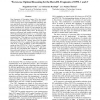482 search results - page 94 / 97 » Expressive probabilistic description logics |
PODS
2011
ACM
12 years 10 months ago
2011
ACM
In the traditional data exchange setting, source instances are restricted to be complete in the sense that every fact is either true or false in these instances. Although natural ...
ECCV
2004
Springer
14 years 9 months ago
2004
Springer
We consider object recognition as the process of attaching meaningful labels to specific regions of an image, and propose a model that learns spatial relationships between objects....
BMCBI
2006
13 years 7 months ago
2006
Background: Quantitative descriptions of amino acid similarity, expressed as probabilistic models of evolutionary interchangeability, are central to many mainstream bioinformatic ...
KR
2010
Springer
14 years 11 days ago
2010
Springer
Horn fragments of Description Logics (DLs) have gained popularity because they provide a beneficial trade-off between expressive power and computational complexity and, more spec...
TOSEM
2002
13 years 7 months ago
2002
Abstract. The Unified Modeling Language (UML) is a family of design notations that is rapidly becoming a de facto standard software design language. UML provides a variety of usefu...

